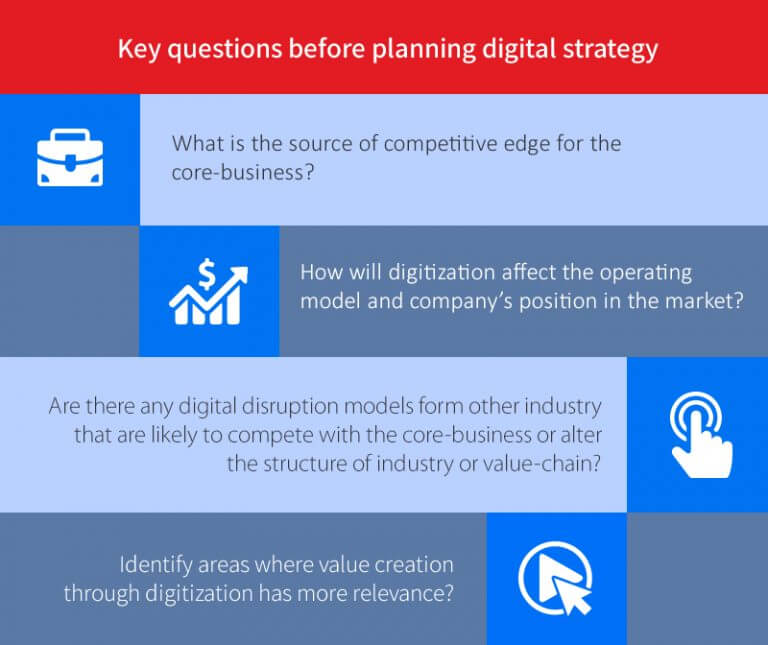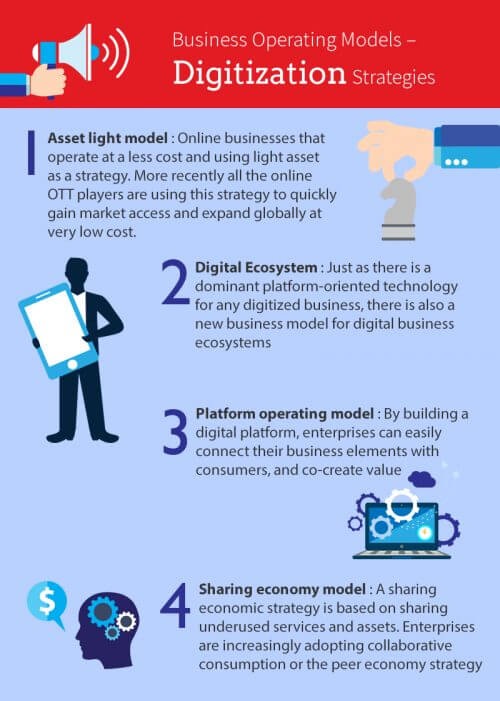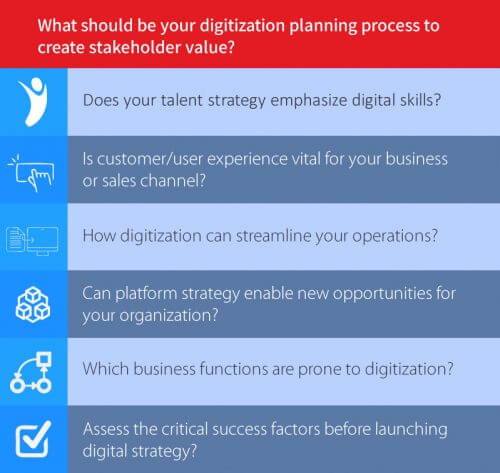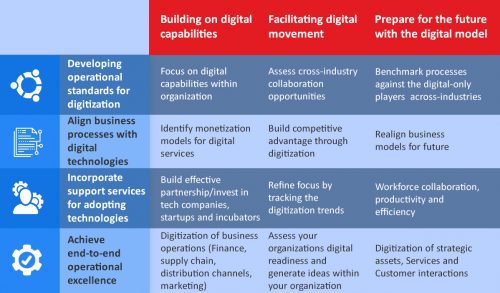Industries are increasingly navigating through a digitized landscape, thus prompting business operations to be in a state of flux.
The penetration of digital technology has led to dramatic implications in terms of profit levels, revenues, and business opportunities. Innovative technologies are an intrinsic part of our day-to-day life amid emerging markets and shifting profit pools. However, despite the deeper penetration of digital technologies, digital forces are yet to be included in the mainstream of companies. A tightly integrated digitization strategy will serve as the differentiator between leaders and laggards. Biggest payouts will go to the companies that adopt a right digital transformation approach. Moreover, fast-followers with operational excellence won’t be far behind. Our collective research indicates a mandate for businesses to strategize digitization and act decisively. Businesses can do so by reinventing their operating model, building strategic partnerships and developing organizational capabilities.
Digitization Across Industries
Digital capabilities and technological adoption are evolving at a supercharged pace. Scrambling the surface to keep up with the relentless rate of evolution is not enough. Today, industries, businesses, and users are on the digital frontier. The ICT sector has taken the digitalization route in a big way, closely followed by retail, BFSI, and pharmaceuticals sectors. Apart from traditional players, digital-only (digital pioneers) players are breaking the silos of industry barriers by driving the digitization journey.
Digitization in Retail
E-commerce does not spell the end of traditional retail stores as both are increasingly getting merged. The impact of digitization is distinctly seen in physical retail stores, traditional brick-and-mortar stores, and overall shopping experience. Consumers are the driving force for the increasing use of digital tools in the retail sector. Since millennial and generation-Z consumers demand personalized and tailored services as well as seamless interactions across multiple channels, retailers have been at the forefront of integrating digital strategies into their overall businesses.
Digital-savvy consumers widely welcome all digital innovations that can provide them with a customer-first experience. Hence, retailers are adopting digital technologies such as artificial intelligence, big data, the Internet of Things (IoT), and augmented reality to digitize a customer’s buying journey. The implementation of such trailblazing digital technologies is fast turning retail stores into true intelligent machines.
For instance, American Apparel has combined augmented reality with social channels and sales. The shopping assistant is an app which only works in store – showing styling options and size charts (among other features) to customers. American Apparel’s implementation of augmented reality helps boost conversions dramatically. Retail giants like Amazon, Casper, and SkinnyPop Popcorn are also integrating innovative technologies – from deploying drones and robotics process automation to inventive pizza and food chain. Another retailer Nordstrom has invested more than 30% of its budget on integrating technologies by setting up an exclusive Nordstrom Innovation Lab. The company has deployed sensing technology with big data to analyze customer preferences based on who comes to their stores, which parts of the store they surf, and for how long.
Digitization in BFSI
Digital transformation is fast spreading across the banking and financial industry. Digital technology continues to drive pivotal changes in the banking sector – offering banks a perfect window to thrive in the digital future. Banks, who are in contemporary times struggling in a low-interest rate environment, are getting more innovative through digitalization (Fintech) to shape their workforce and strategic partnerships. Designing digital capabilities to adapt to the ever-changing consumer behavior has taken banking to a new level, especially digital-only or mobile-only banks such as Monzo, Starling, Atom, Fidor Bank, Number26, Hello Bank, etc. The digital-only players are the newest disruptors in the banking industry.
Algorithmic trading and electronification of exchanges are diluting the role of humans across asset classes and equities. Blockchain holds immense promise in radically transforming the payments, vendor finance landscape. Data analytics and machine learning are playing a key role in preparing FinTechs for the future. However, it will require banks to undertake huge efforts to integrate their digitized model in their existing business and transform their operations.
Digitization in Pharma
The pharmaceuticals and life sciences industry is increasingly applying digital technologies to improve the productivity of its core manufacturing operations and supply chain. Since businesses in the pharma industry face challenges including globalization, supply chain complexities, and precision medicine demands – digitization holds huge potential for companies to excel not only in operations but also in innovating new drugs.
The pharma industry is walking down the digitization road to increase visibility in supply chain operations for taking faster decisions. Resultantly, the operational processes are turning adaptive, facilitating accuracy, manufacturing productivity, and improved inventory standards. By implementing cloud solutions, pharma companies are also developing global integrated supply chain networks. Technological innovation such as 3D printing is making decentralized production cost-effective. Moreover, advanced robotics is revolutionizing the pharma industry by providing a step-change in human-machine interaction, providing a true source of competitive advantage.
For instance, Proteus Digital Health offers a medication adherence solution with ingestible sensors. Companies like Pfizer and Bristol-Myers Squibb are also integrating cloud solutions, analytics platforms, and RPA in their supply chain processes. Pharma companies are partnering with IoT and wearable technology startups to develop devices for the inheritance of patients’ real-time health data. One such company in the digital domain, Pear Therapeutics, partners with pharma companies to develop tailored patient engagement applications. Novartis and Roche are among the pharma giants that are beginning to latch onto digital pharma and precision medicine solutions.
Scaling an Effective Digitization Strategy
The winner-take-all strategy is not evident in the digitized world, as the scale and durability of such business is quite uncertain. The position of the ‘digital-only’ model is also vulnerable to market forces. New digital players have toppled traditional winners as Internet-based businesses are mainly focused on digital ad revenue.
Our research indicates a major mismatch between companies’ digital investments and aspects in which digitization is affecting revenue pools. A successful digitization strategy must focus on changing a business’s scope, including pure-play disruptions in the business. A digitization strategy must include agile operations, organizational effectiveness, culture, and talent. Even though most executives would fancy the sort of digital ecosystem created by digital giants like Google, Alibaba, and Amazon, companies lack disruptive strategies for overall digital maturity.
Companies need to be clear about their digital strategy and assess internal capabilities. Executive teams must answer key questions before they start planning digitization.

Understanding the role of digitization in organizations and using the right operating model can help companies transform businesses dramatically. Decisive actions will also help enterprises place digital at the core of their business strategy. A digital operating model is more about successfully creating a digital innovation culture while being prepared for proactively responding to industry shifts. Digitization requires a massive shift in executing and operating digital technologies across a wide range of disciplinary and organizational boundaries – creating a digital ecosystem rather than setting up a separate digital department. The digital operating model must support enabling technologies and dynamic working ways. Furthermore, it must power the integration of data analytics with human-centered businesses. Our research findings suggest four prominent digital operating models for businesses across all industries.
Asset Light Model
An asset-light business model helps reduce operating costs and risks. Businesses adopting the asset light model focus on creating value through outsourcing, asset sharing, licensing in, and licensing out. Additionally, an asset-light model helps businesses expand their reach to a new location at the click-of-a-button by increasing partnerships and effective networking capabilities. Businesses implementing a digitization strategy can use an asset light model while retaining their focus on R&D, strategic alliances, and synergic partners.
For instance, Apple has implemented an asset light model by outsourcing chip hardware to the Taiwan Semiconductor Manufacturing Company. The shift to digitization served Apple well as the company started focusing on digitization after outsourcing manufacturing elements. Similarly, Indian e-commerce giant Snapdeal has garnered a huge customer base by consistently focusing on improving digital customer journeys with an asset light model.
Digital Ecosystem Model
Like a dominant platform-oriented strategy adopted by digital players, there is also a new business model of digital business ecosystems. In fact, the digital ecosystem model is fast becoming the go-to operating model for businesses embarking on the digitization path.
For instance, Google launched its smartphone activator Android by allowing developers to build apps for its app store. This instrumental model has also been adopted by Apple for its iOS app store. By leaning on exterior players within the industry, enterprises are quickly delivering products and services that exceed consumer expectations. Netflix has also transformed itself from being a video-rental service platform to a content-streaming platform by opening up its application programming interface (API) to partners. Such a step has helped the company focus on its digitization move to analyze consumer trends and preferences. Digitization strategy of Netflix allowed it to integrate the platform across multiple devices – toppling established companies like Blockbuster.

Platform Operating Model
A platform lifts you up on which others stand. The same is true in businesses developing innovative digital platforms. By building a digital platform, enterprises can easily connect their business elements with consumers, and co-create value. This ‘plug-and-play’ capability is defining a characteristic of platform intelligence. Again, considering the smartphone market, the triumph of Android and iOS comes not from features, but from an innovative app platform on which external developers create futuristic applications. At the other end, Microsoft has been releasing excellent smartphones but lags behind in terms of adoption, due to the inability of creating a successful platform for developers.
The use of platforms extends beyond the technology sector. Retailers are also shifting their focus from distribution channels to engagement platforms. For instance, eBay and Amazon are leading the way with traditional retailers following suit. Nike is also slowly shifting from selling products to building platforms on the success of its Digital Sport products. The company had recently launched its Nike+Accelerator to help enterprises build on the platform. Platform-oriented businesses are driven by transformative technologies including cloud, social and mobile. The result is a global network of entrepreneurs, consumers, and collaborators, who can create value by contributing to content and services.
Sharing Economy Model
A sharing economy strategy is based on under-used services and assets. Enterprises are rapidly adopting collaborative consumption or the peer economy strategy. In such a strategy, businesses facilitate owners to rent out assets such as car, house or electronic items.
The most successful digitized enterprises with sharing economy models are into ride sharing (Lyft, Didi, Uber,and Yandex) or accommodation sharing (Airbnb, 9flats, onefinestay). Companies have also succeeded in other areas by identifying market inefficiencies. Some enterprises have successfully established shop and office sharing (We Are Pop Up), and meal sharing (Travelling Spoon, EatWith).

Cultural change, short-term goals, and lack of clarity have posed major hurdles to the digitization wave. One could assume that the rise of digital consumers is a key factor driving digitization across industries. However, this could hold true only for a few companies. Increased information availability, transparency through digital means, use of technology, and better connectivity are forcing companies to think of new ways to connect, communicate and collaborate with stakeholders.
Reinventing the Core – Implementing Digitization Strategy
There is an eclectic gap between organizations planning to discover digital future and actual efforts to prepare for digital disruption. Most organizations are struggling with resources, talent, especially business priority that hampers the effectiveness of digitization. Although a few organizations have clearly defined roles of digital strategy or chief digital officer, leveraging cross-function collaboration for managing digitization remains a major hurdle. Organizations often fall into the trap of the functional silos or standalone project that lacks clear strategic or cultural thrust. Unless digitization loopholes are addressed earlier, companies are bound to fail in their digital strategies.
When it comes to developing a digitization strategy, most leadership teams focus on adopting technology and ignore directing the company’s energy toward practical digital initiatives. An effective strategy must be a mix of high-impact digital initiatives with a bold vision.
Identify Possibilities
With the existing froth around digital technology, it is imperative for businesses to realize the confluence of smart devices, massively powerful cloud computing technologies and low-cost networks. These innovative technologies are changing the calculus of running a business. What used to be pipe dreams once are now turning into reality – autonomous vehicles. The line between products and services is fading – everything seems possible.
Track Digital Trends
Businesses must also realize that the direction of technological disruption in the industry can be foreseen. The contours of disruption are discernible before they begin to emerge as a reality. For implementing a digitization strategy, leaders must understand how digital trends are paving the future of the industry. Defining the direction of disruption helps businesses remove variables from digital equations.
Business Function Integration
Another important aspect for businesses is to realize that digital ecosystems are making a big difference in operating costs. For instance, the pharmaceutical sector operates in a highly complex environment. It is easy to anticipate that the digital future of pharma players will be followed by precision medicine technology, patient interface platforms, health assessment sensors, integrated IT systems and doctor-patient interaction platforms. However, a digitization strategy for any pharma company must not ignore the ground rules. Pharmaceutical sector’s digitization fundamentals include regulation, expensive healthcare IT infrastructure, aging robotics infrastructure and data protection measures. An approach on a broad scale allows businesses to rethink what a workable strategy looks like.
Build a Roadmap for Success
Companies also need a clear understanding of where the industry is headed and which digital investments will get the business there. This indicates defining the business’s digital destination, focusing on those that will be most impactful. For instance, an automotive manufacturer ready to adopt a digitization strategy needs to understand that the industry is making use of digital technologies for powering features including predictive maintenance, vehicle monitoring, and connected logistics. In such a situation, the automotive manufacturer must craft a clear roadmap by developing a set of innovative ideas and prioritizing them.
Incremental Approach
Businesses must break their digitization strategy into a series of milestones. Companies approaching a digital future must organize their strategies in accordance with upcoming technological innovations and evolve with shifting consumer demands.
For instance, Uber was initially launched as an on-demand car hire app, which then solved customer pain points. Subsequently, customer demand and innovative technologies enabled the company to develop a platform for drivers enlisting their own cars in a shared economy model. Today, Uber has facilitated sharing rides through UberPOOL, and has also launched Uber Freight to connect truckers. With the emergence of innovative technologies like artificial intelligence and augmented reality, Uber’s subsidiary Otto is planning to launch autonomous vehicles.
Similarly, the platform-based hotel businesses will also start planning to integrate AI and IoT in their customer touch points. This indicates sponsoring smart homes and rooms on their platform. Businesses opting for a digitization strategy should start focusing on high-priority needs and the cumulative effect will help construct the digital business of the future.
Workplace Strategy
Workplace strategy has to be an integral part of the digital strategy. Enabling workplace agility and collaboration will provide more avenues for organizations to grow. Increased use of activity-based working across office locations is transforming the model for a professional working environment. Several professional services companies have already adopted open plans and are moving toward a hybrid model of activity-based working and fixed cabins/desks as part of the workplace strategy. Companies like Microsoft, Google, and Cisco have gone further and established collaborative open plans as part of their digitization strategies. Overall, around 70% of the US offices operate on an open floor plan.
Our digitization strategy framework directs companies to capture opportunities – from a diagnosis to deployment phase. The digitization framework sets the basis for building on digital capabilities, facilitating digital movement, and preparing for the future with the digital model. We recommend organizations to employ the following framework for developing a successful digitization strategy.

…way ahead in the digital revolution
Businesses pursuing digital transformation will face challenges. The challenges will include IT integration falling behind the schedule, decisive conflicts, and regulatory concerns. Companies might also face challenges in developing the right culture and recruiting new talent in adapting to new technologies. Digital transformation is not a science – it is an imperative – the only way forward for enterprises. Hence, companies must take cognizance of important markers of success. The integration of innovative technologies will automatically reveal new ways to accelerate revenue pools. It is important that a business doubles down on efforts to strategize digital transformation initiatives.
To conclude, businesses must realize that what is prevailing is not exactly a digital transformation but more of an opportunity for businesses to rethink about retaining their competitive edge. Digital technologies and tools serve as the catalysts, and a well-oiled digitization strategy is a formula for future business success









